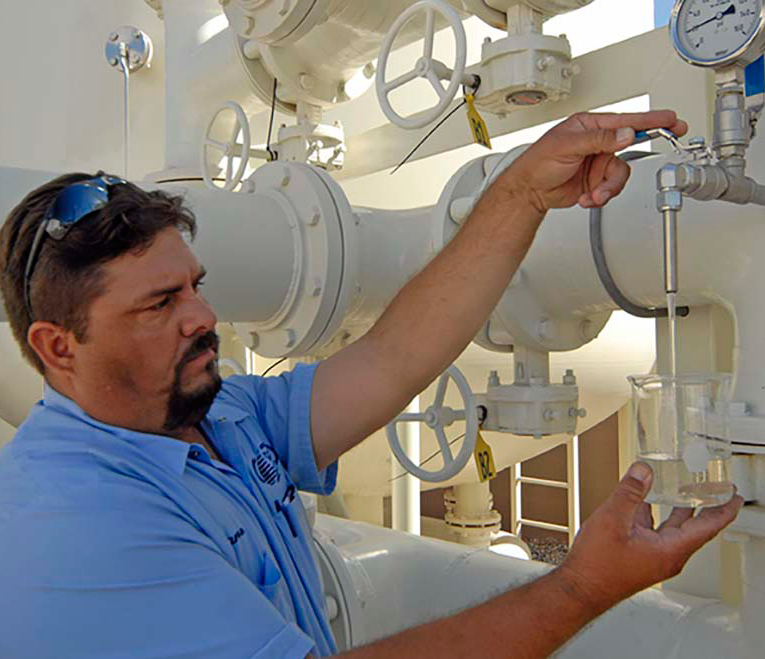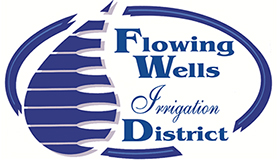
Flowing Wells Irrigation District
Annual Water Quality Report
for Calendar Year 2023
Este informe contiene informactión muy importante sobre el aqua usted bebe.
Tradúscalo ó hable con alguien que lo entienda bien.
PWSID# AZ04-10051
FWID is responsible for water quality throughout its system, ensuring that the water delivered is clean, safe and meets all local, state and federal drinking water health standards.
The Safe Drinking Water Act requires public water systems to comply with EPA and ADEQ drinking water regulations and, at established monitoring frequencies, District staff collects water samples from wells, storage tanks, sample stands and at entry points to the distribution system. Those samples are then taken to a state-licensed laboratory for analysis and test results are reported to the District and the Water Quality Division of the Arizona Department of Environmental Quality.
Contact Us
We want our valued customers to be informed about their water quality. If you would like to learn more about public participation or to attend any of our regularly scheduled meetings, please contact Richard M. Rubal at (520) 887-4192 or email rrubal@fwid.org for additional opportunity and meeting dates and times.
Drinking Water Sources
The sources of drinking water (both tap and bottled water) include rivers, lakes, streams, ponds, reservoirs, springs, and wells. As water travels over the surface of the land or through the ground, it dissolves naturally-occurring minerals, and in some cases, radioactive material, and can pickup substances resulting from the presence of animals or from human activity.
In order to ensure that tap water is safe to drink, EPA prescribes regulations which limit the amount of certain contaminants in water provided by public water systems. Food and Drug Administration (FDA) regulations establish limits for contaminants in bottled water which must provide the same protection for public health.
Our water source(s):
Our water system has 9 wells that draw water from the Upper Santa Cruz sub-basin of the Tucson Active Management Area basin.

Drinking Water Contaminants
Microbial Contaminants: Viruses and bacteria that may come
from sewage treatment plants, septic systems, agricultural livestock
operations, and wildlife.
Disinfectants and Disinfection By-products: Water additives used
to control microbes, and the by-products of interactions between
disinfectants and natural organic materials in water.
Inorganic Contaminants: Salts, metals, and other inorganic
contaminants that can occur naturally or result from urban stormwater
runoff, industrial or domestic wastewater discharges, oil and gas
production, mining, or farming.
Pesticides and Herbicides: Synthetic organic compounds that
come from agriculture, urban storm water runoff, and a wide
variety of residential uses.
Organic Chemical Contaminants: Synthetic and volatile organic
chemical by-products that come from industrial processes,
petroleum production, gas stations, urban storm water runoff, and
septic systems.
Radioactive Contaminants: Can be naturally occurring or be the
result of oil and gas production and mining activities.
Vulnerable Population
Drinking water, including bottled water, may reasonably be expected to contain at least small amounts of some contaminants. The presence of contaminants does not necessarily indicate that water poses a health risk. Some people may be more vulnerable to contaminants in drinking water than the general population.
Immuno-compromised persons such as persons with cancer undergoing chemotherapy, persons who have undergone organ transplants, people with HIV-AIDS or other immune system disorders, some elderly, and infants can be particularly at risk from infections. These people should seek advice about drinking water from their health care providers.
For more information about contaminants and potential health effects, or to receive a copy of the U.S. Environmental Protection Agency (EPA) and the U.S. Centers for Disease Control (CDC) guidelines on appropriate means to lessen the risk of infection by Cryptosporidium and microbiological contaminants call the EPA Safe Drinking Water Hotline at 1-800-426-4791.
Source Water Assessment
This PWS did not receive a SWAP because the PWS was inactive at the time, the PWS did not exist, or the State failed to perform the assessment. Further source water assessment documentation can be obtained by contacting ADEQ.
Definitions
Treatment Technique (TT): A required process intended to reduce the level
of a contaminant in drinking water.
Level 1 Assessment: A study of the water system to identify potential
problems and determine (if possible) why total coliform bacteria was present.
Level 2 Assessment: A very detailed study of the water system to identify
potential problems and determine (if possible) why an E. coli MCL violation
has occurred and/or why total coliform bacteria was present.
Action Level (AL): The concentration of a contaminant which, if exceeded,
triggers treatment, or other requirements.
Maximum Contaminant Level (MCL): The highest level of a contaminant
that is allowed in drinking water.
Maximum Contaminant Level Goal MCLG): The level of a contaminant
in drinking water below which there is no known or expected risk to health.
Maximum Residual Disinfectant Level (MRDL): The level of
disinfectant added for water treatment that may not be exceeded at the consumer’s tap.
Maximum Residual Disinfectant Level Goal (MRDLG): The level of
disinfectant added for treatment at which no known or anticipated adverse
effect on health of persons would occur.
Minimum Reporting Limit (MRL): The smallest measured concentration
of a substance that can be reliably measured by a given analytical method.
Millirems per year (MREM): A measure of radiation absorbed by the body
Not Applicable (NA): Sampling was not completed by regulation or was not required
Not Detected (ND or <): Not detectable at reporting limit
Nephelometric Turbidity Units (NTU): A measure of water clarity
Million fibers per liter (MFL)
Picocuries per liter (pCi/L): Measure of the radioactivity in water
Unit Conversions:
ppm: Parts per million or Milligrams per liter (mg/L)
ppm x 1000 = ppb
ppb: Parts per billion or Micrograms per liter (µg/L)
ppb x 1000 = ppt
ppt: Parts per trillion or Nanograms per liter (ng/L)
ppt x 1000 = ppq
ppq: Parts per quadrillion or Picograms per liter (pg/L)
Lead Informational Statement:
Lead, in drinking water, is primarily from materials and components associated with service lines and home plumbing. If present, elevated levels of lead can cause serious health problems, especially for pregnant women and young children.
Flowing Wells Irrigation District is responsible for providing high quality drinking water, but cannot control the variety of materials used in plumbing components. When your water has been sitting for several hours, you can minimize the potential for lead exposure by flushing your tap for 30 seconds to 2 minutes before using water for drinking or cooking.
Information on lead in drinking water, testing methods, and steps you can take to minimize exposure is available from the
Safe Drinking Water Hotline or at www.epa.gov/safewater/lead.
Water Quality Data – Regulated Contaminants
As authorized and approved by EPA, the state has reduced monitoring requirements for certain contaminants to less often than
once per year because the concentrations of these contaminants are not expected to vary significantly from year to year. Some of
our data, though representative, is more than one year old.
| Disinfectants | MCL Violation Y or N |
Average |
Range | MCL | MCLG | Sample Month & Year |
Likely Source of Contamination |
| Chlorine/Chioramine (ppm) | N | 0.55 | 0.45 to 0.67 | 4 | 4 | 2023 | Water additive used to control microbes |
| Disinfection By-Products | MCL Violation Y or N |
Highest Location Average or Highest Level Detected |
Range Low-High | MCL | MCLG | Sample Month & Year |
Likely Source of Contamination |
| Total Trihalomethanes (TTHM (ppb) | N | 7.2 | 2 to 10.6 | 80 | N/A | 2023 | Byproduct of drinking water disinfection |
| Lead & Copper | AL Violation |
90th Percentile | Number of Samples Exceeding the AL |
AL | ALG | Sample Month & Year |
Likely Source of Contamination |
| Copper (ppm) | N | 0.10 | 1 | 1.3 | 1.3 | 7/2022 | Corrosion of household plumbing systems; erosion of natural deposits |
| Radionuclides | MCL Violation Y or N |
Average or Highest Level Detected |
Range | MCL | MCLG | Sample Month & Year |
Likely Source of Contamination |
| Alpha Emitters including uranium (pCi/L) | N | 3 | 0 to 3 | 15 | 0 | 2/2022 | Erosion of natural deposits |

| Inorganic Chemicals (IOC) | MCL Violation Y or N |
Average or Highest Level Detected |
Range | MCL | MCLG | Sample Month & Year |
Likely Source of Contamination |
| Arsenic1 (ppb) | N | 5.6 | 1.2 to 5.6 | 10 | 0 | 2019 – 2023 | Erosion of natural deposits, runoff from orchards, runoff from glass and electronics production wastes |
| Barium (ppm) | N | 0.12 | 0 to 0.12 | 2 | 2 | 2019 – 2021 | Discharge of drilling wastes; discharge from metal refineries; Erosion of natural deposits |
| Chromium (ppb) | N | 4.3 | 0 to 4.3 | 100 | 100 | 2019-2021 | Discharge from steel and pulp mills; Erosion of natural deposits |
| Fluoride (ppm) | N | 0.53 | 0 to 0.53 | 4 | 4 | 2019-2021 | Erosion of natural deposits; water additive which promotes strong teeth; discharge from fertilizer and aluminum factories |
| Nitrate2 (ppm) | N | 3.8 | 0.95 to 3.77 | 10 | 10 | 2/2023 | Runoff from fertilizer use; leaching from septic tanks,sewage; erosion of natural deposits |
| Selenium (ppb) | N | 7.3 | 0 to 7.3 | 50 | 50 | 2019-2021 | Discharge from petroleum and metal refineries; erosion of natural deposits; discharge from mines |
| Sodium (ppm) | N | 310 | 25 to 310 | N/A | N/A | 2021 | Erosion of natural deposits |
Water Quality Table – Unregulated Contaminant Monitoring Rule 5 (2023-2025)
Your drinking water was sampled for the presence and concentration of 29 different per- and polyfluoroalkyl substances, some known by the acronyms PFAS, PFOA, PFNA, PFHxS, PFBS, and GenX, a group of contaminants in the final stages of becoming regulated by the EPA. PFAS are man-made chemicals that are resistant to heat, water, and oil. They have been used since the 1940s to manufacture various consumer products, including fire-fighting foam and stain resistant, water-resistant, and nonstick items. Many PFAS do not break down easily and can build up in people, animals, and the environment over time. Scientific studies have shown that exposure to certain PFAS can be harmful to people and animals, depending on the level and duration of exposure.
To learn more about this group of chemicals, we encourage you to read the ADEQ-provided “PFAS 101 Fact Sheet” and to visit the ADEQ website at https://www.azdeq.gov/pfas-resources
| Metals | Average | Range of All Samples (Low-High) |
Sampling Date | MRL | Likely Source of Contamination |
| Lithium (ppb) | 72 | 0 to 228 | 2023 | 9 | Naturally occurring metal that may concentrate in brine waters; lithium salts are used as pharmaceuticals, used in electrochemical cells, batteries, and in organic syntheses. |
| Per- and Polyfluoroalkyl Substances (PFAS) |
Average | Range of All Samples (Low-High) |
Sampling Date | MRL | Likely Source of Contamination |
| Perfluorobutanesulfonic acid (PFBS)* (ppt) | 0.67 | 0 to 4 | 2023 | 3 | See above |
| Perfluorooctanesulfonic acid (PFOS) (ppt) |
0.83 | 0 to 6 | 2023 | 4 | See above |
| Perfluorooctanoic acid (PFOA) (ppt) | 0.83 | 0 to 5 | 2023 | 4 | See above |
| Perfluorohexanesulfonic acid (PFHxS)* (ppt) |
2.50 | 0 to 9 | 2023 | 3 | See above |
| Perfluorohexanoic acid (PFHxA) (ppt) | 0.50 | 0 to 3 | 2023 | 3 | See above |
| Perfluoropentanoic acid (PFPeA) (ppt) | 0.58 | 0 to 4 | 2023 | 3 | See above |
* EPA is proposing a Hazard Index MCL to limit any mixture containing one or more of PFNA, PFHxS, PFBS, and/or GenX Chemicals. The Hazard Index considers the different toxicities of PFNA, GenX Chemicals, PFHxS, and PFBS. For these PFAS, water systems would use a hazard index calculation to determine if the combined levels of these PFAS in the drinking water at that system pose a potential risk and require action (Source: EPA Fact Sheet: Understanding the PFAS National Primary Drinking Water Proposal Hazard Index).
Violation Summary (for MCL, MRDL, AL, TT, or Monitoring & Reporting Requirement)
| Violation Type | Explanation, Health Effects | Time Period | Corrective Actions |
| Late Reporting | Arsenic, no health effects | 2nd quarter 2023 | Submitted results |
| Missed monitoring | Total Coliform, no health effects | November 2023 | Returned to compliance with December sampling – no coliform detected |
| Missed monitoring | Disinfection Byproducts, no health effects | 4th quarter 2023 | Took samples in November instead of October, as scheduled – results well below the MCL |

1 Arsenic is a mineral known to cause cancer in humans at high concentration and is linked to other health effects, such as skin damage and circulatory problems. If arsenic is less than or equal to the MCL, your drinking water meets EPA’s standards. EPA’s standard balances the current understanding of arsenic’s possible health effects against the costs of removing arsenic from drinking water, and continues to research the health effects of low levels of arsenic.
2 Nitrate in drinking water at levels above 10 ppm is a health risk for infants of less than six months of age. High nitrate levels in drinking water can cause “blue baby syndrome.” Nitrate levels may rise quickly for short periods of time because of rainfall or agricultural activity. If you are caring for an infant, and detected nitrate levels are above 5 ppm, you should ask advice from your health care provider.

If you would like a copy of this report mailed to you, please call, stop by, or email the office and we will be happy to get one to you or
click here for a downloadable copy (PDF format).
Please share this information with other people who drink this water, especially those who may not have received this notice directly (for example, people in apartments, nursing homes, schools, and businesses). You can do this by posting this notice in a public place or distributing copies by hand or mail.